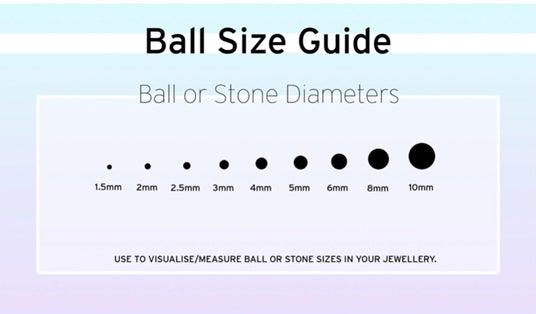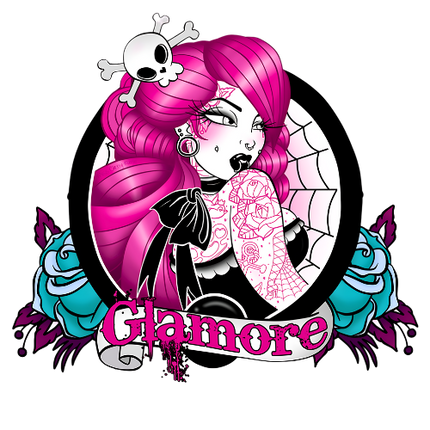Jewellery Info
Here at Glamore we believe buying body jewellery shouldnt be so complicated, So we have tried to make things simple with these size charts and piercing guides!
We have got some handy charts, guides & plenty of information that will help you with bar lengths, ring sizes, understanding the difference between external and internal thread body jewellery and of course........what piercing fits where!!!
We will show you the standard sizes used generally for each body part , But please note that everybody is different, Every piercer is different and our guides are put together to help you as much a possible.
Sizing your jewellery

Knowing your piercing thickness (Gauge)

Measuring the thickness of your piercing, Gauge is a term used for the thickness of a piercing, It can be very confusing for many! As the higher the number the thinner the thickness of the jewellery will be.
For example, A 14 gauge barbell is 1.6mm, Whereas a 16 gauge barbell is 1.2 mm
By wearing jewellery that is too thick, You will stretch your piercing hole, Some people have the intention of doing this, but if thats not your aim then we suggest sticking to the same size you have. Keep in mind by wearing a thinner gauge you can shrink your piercing hole too!
18 - 20 Gauge - Nose piercings / some lobes
16 gauge - Cartilage, Helix, Conch, Rook, Tragus, Daith, Septum, Some Lip piercing
14 gauge - Belly button, Industrial, Lip, Nipple, Microdermals, Surface piercings, Genital piercings, Cheek Piercings, Tongue piercings
Know your ring size!

Getting the right ring size is very important for your piercing, Diameter is used to determine the size of many types of rings, Horseshoe rings, seamless, captive bead rings, hinged rings and any other circular style body jewellery.
To ensure you have the correct fit for your piercing it is importnant you choose the correct internal diameter. A simple way of measuring the diameter is to simply place the ring on a mm ruler and measure the ring via the distance across the widest point (You do not include the actual ring when measuring, Just the hole (refer to picture)
To find out the best internal diameter for your piercing either measure an existing piercing ring you love the size of (as detailed above)
Or as a gudie simply measure the length from your piercing hole to the edge of your ear / lip / nose to ensure the best fit.
Knowing your bar size!

Finding the right bar length, When measuring the length of a piercing it is important to know that is only the bar of the piercing and not of the whole length , eg you dont include the thread/ ball or base of labret.
When it comes to measuring curved barbells, You must measure the inside straight line from ball to ball, Dont include the bend in the bar.
Understanding the correct length of your piercing will prevent any discomfort during wear and give you the best possible look. Too short can cause pinching , whereas , If too long it can easily slide and become irritated.
Jewellery Material
When picking what material to use for your piercing it is important to consider that everybody is different when it comes to what they can and cant wear and fir in their priice range.
316L Surgical steel
The most common material among body jewellery is 316L surgical steel therefore we stock mostly surgical steel products, As it suits their needs fine. althought we do cater for customers with allergies and other prefrences ; making sure we have mixed material products including G23 titanium, Bioflex | bioplast, and more!
G23 Solid Titanium
Titanium is considered to be one of the higest quality metals when it comes to piercings, healed or fresh. making it a great choice and favourite choice for people with allergies as its considered hypoallergenic. Some products can say titanium but only be plated so please always look out for the G23 titanium as this is what you require.
Bio-plast / Bioflex
Bio-flex is often an option with those with allergies to metal. Bioflex is an extremely comfortable material making it very popular, Although shouldnt be worn in fresh piercings , or for long periods of time in healed piercings as over time can get microscopic scratches harbouring bacteria which can lead to infection.
Rocks and semi precious stones
Rocks and semi precious stones make for truly beautiful pieces of body jewellery , From romantic rose quartz to magical opal this organic material truly does make an impact! Although please be careful as if handled roughly they can break easily.
Acrylic
Acrylic body jewellery is known for being super light an diverse as it can come in almost any colour and design imaginable! It is not suggested for fresh piercings as it cant be properly sterilised.
ALLERGY INFO
When getting a piercing it is importnant to understand there is a healing process and this can sometimes be misconstrued for an allergic reaction or infection. It can be normal to experiance bruising and a little bleeding after undergoing a fresh piercing. As the piercing heals swelling will lessen and the pierced area will feel less irrated. Normal signs of healing also include some crusties, and clear fluid. However if you are ever concerned return to the piercer who done the procedure.
A first sign of allergic reaction will be a rash, or severe redness around the body piercing, If you have any excess itching with these signs then we do suggest you visit a professional piercer right away.
The two main causes of allergic reactions are usually the material being used in your piercing and/ or the cleaning soloution. If you belive its the material causing the reaction then its wise to find out what material the body jewellery is made from so you can swap it for something that your body agree's with . People tend to be sensitive to nickel and in this case, seek metals such as titanium, glass, Gold
Measuring Guide!

The above measuring guide shows the different ways in which you can measure your body piercing correctly.
'G' Line represents the gauge (thickness) of the bosy piercings. This maybe difficult to determine with a ruler.
'D' line refers to the diameter of a piercing ring, The diameter determines the inside ring size of horseshoes piercings, seamless rings, twisters and ball closure rings It is always the inside diameter in which you measure your n=body jewellery, (Not including the actual ring itself)
'L' Line simply shows the length of piercing bars, Usually the length will be the straight line of a body piercing but in cases of a curved barbell you will be measuring the inside bar length (this is measured on the straight, rather than measuring around the curve) as diagram shows.
'B' Line shows the ball size, when measuring the ball size simply measure the widest part of the ball length this will give you the correct ball size, As the diagram shows.
Plugs & Tunnels Gauge Chart!

It is important when buying stretchers that you get the correct size, So you dont cause any discomfort or harm. The tunnel and plug size chart shows the gauge (thickness) of ear plugs, tunnels and tapers to ensure you pick the perfect size for your stretched lobes.
Please be aware that everybody is different and ear stretching is a body mod that should be taken seriously, We want to make sure you look super cute but also feel super comfy.
Piercing thread types

Dont know the difference between external and internal piercings? Our threading piercing guide shows that internal threaded piercings have a threaded hole inside the barbell, And then an attached thread protuding from the ball whereas an external threaded piercing has a thread on the end of the barbell, and it is placed inside a threaded hole in the ball. Then there is a push pin with a threadless pin protruding from the ball which slides into the hollow bar.
Know your ball size!

When it comes to ball and crystal sizes it simply depends on your piercing and prefrence, But we like to support you and as much as possible when selecting the right body jewellery for you! As a general piercing ball and jewel size guide 2.5mm to 4mm is the size most desired by our customers for labret studs, eyebrow piercings & cartilage piercings. Nipple, tongue piercings and belly bars are generally 5 and 6mm. Cute nose studs suit a 2-4mm.The guide above will help you visualize the size you want / need.


